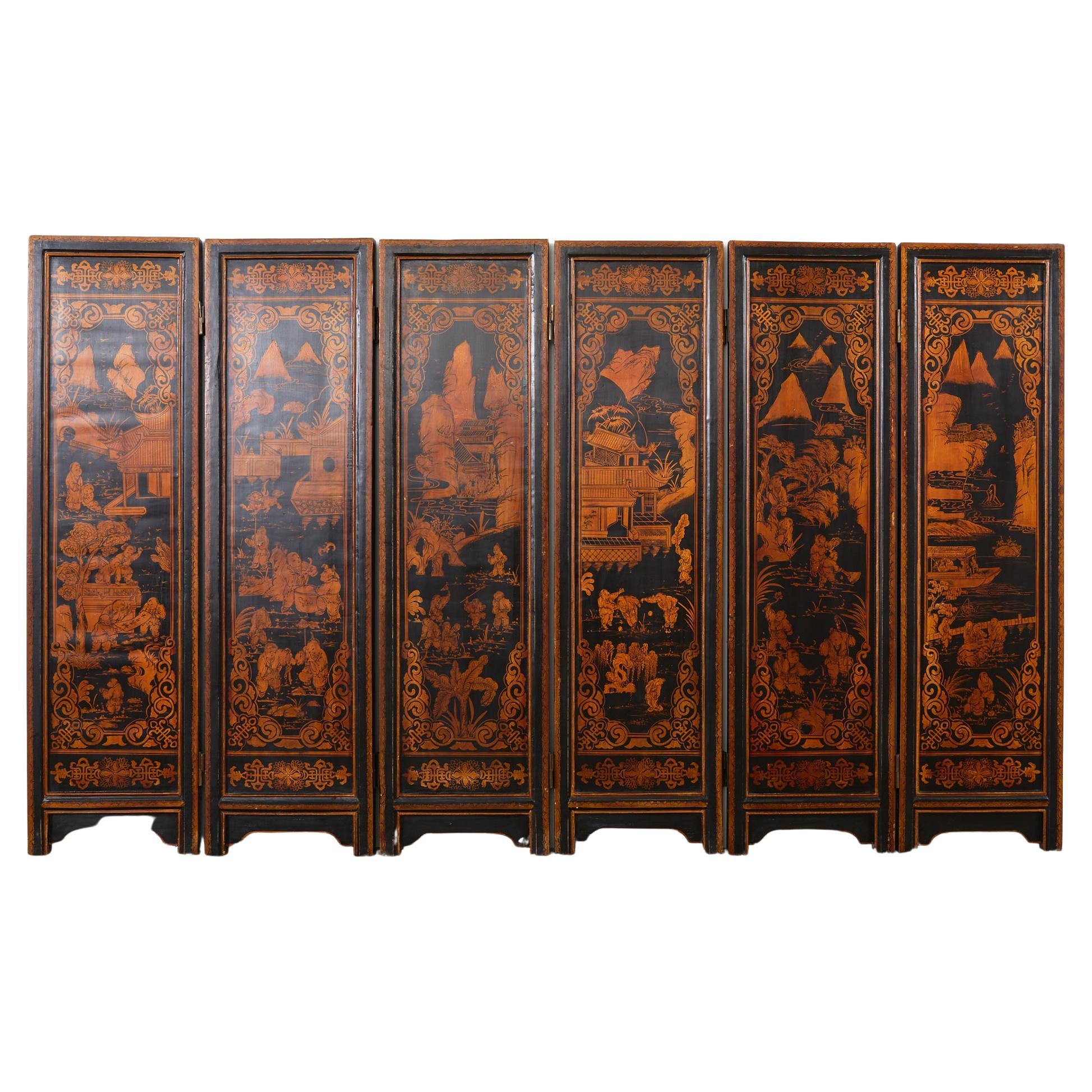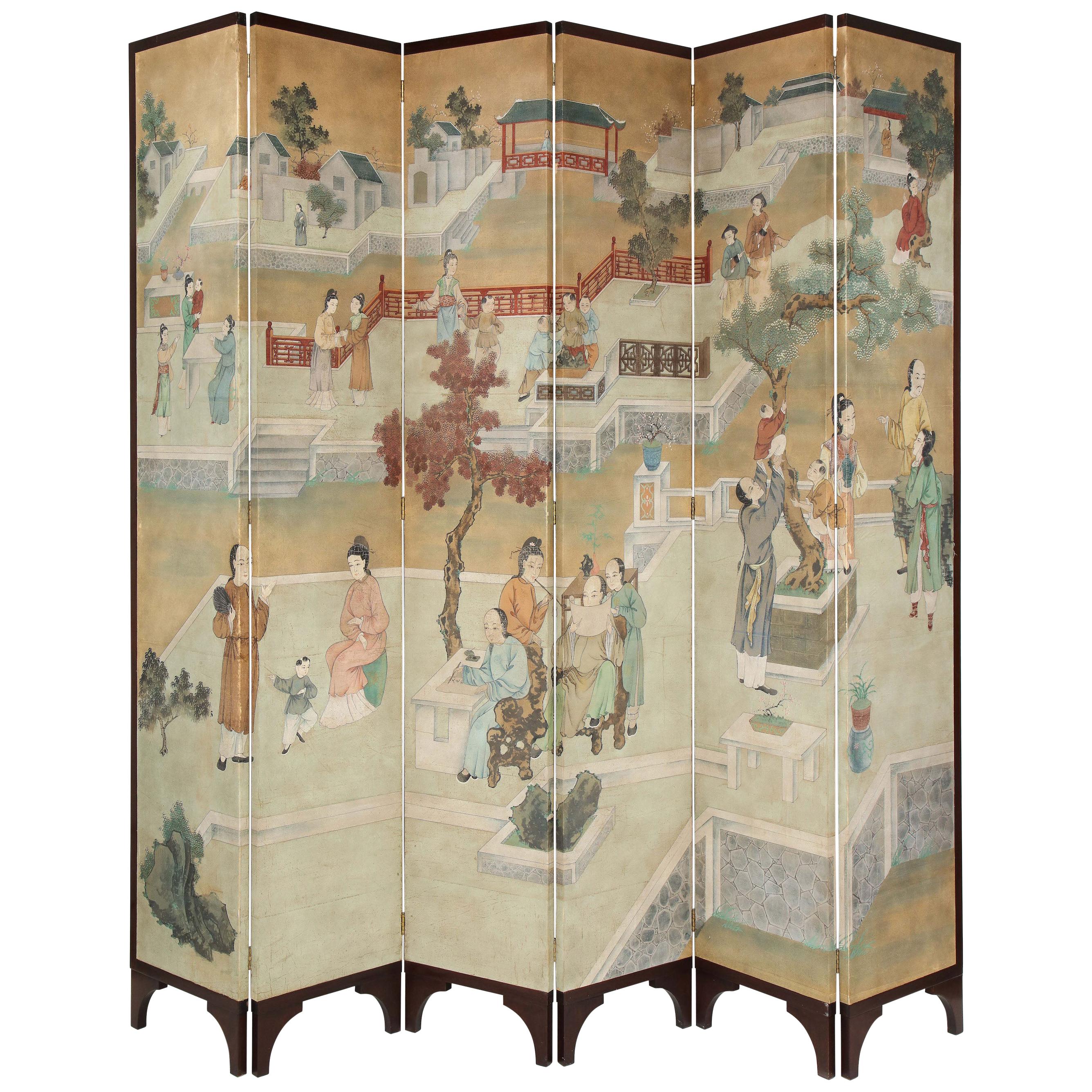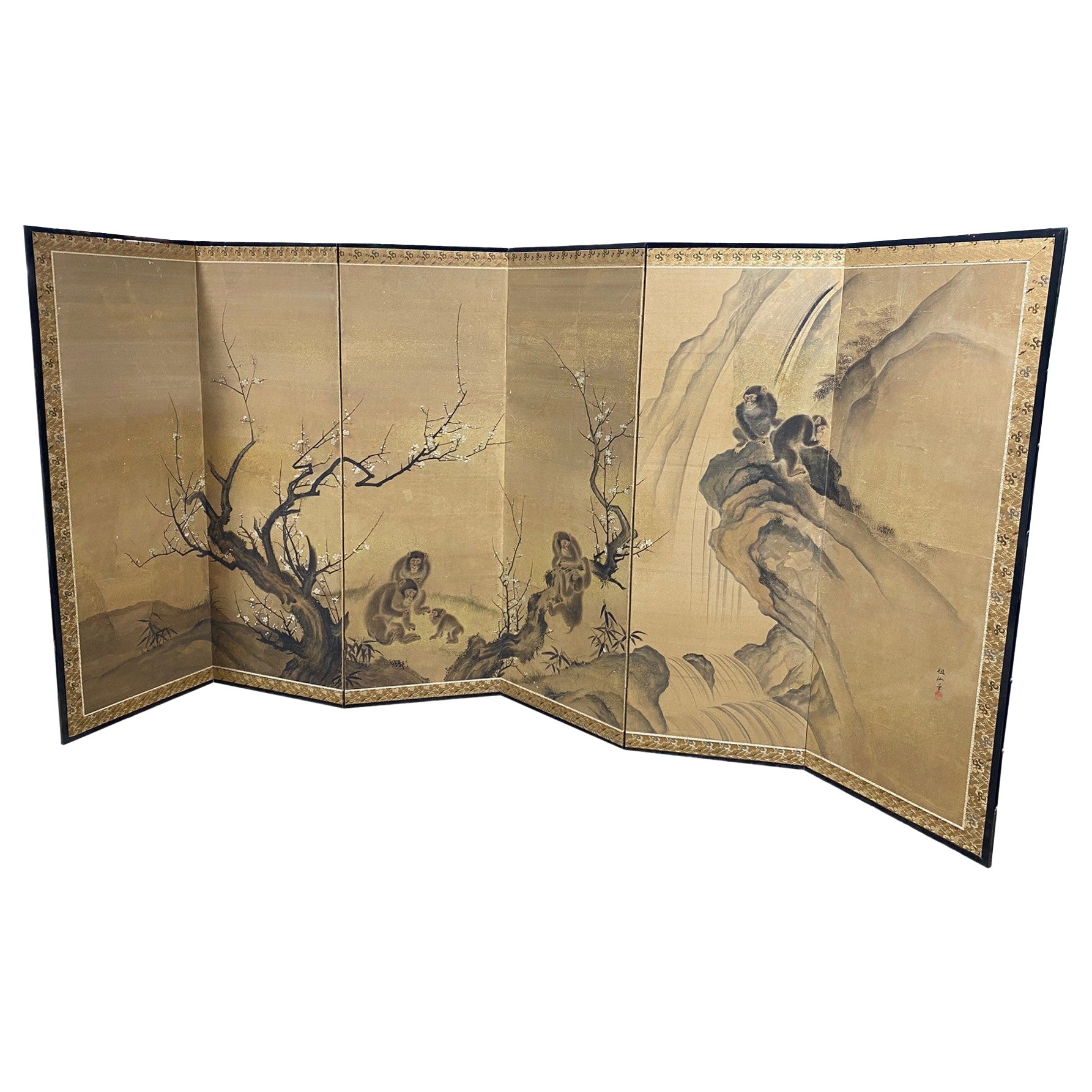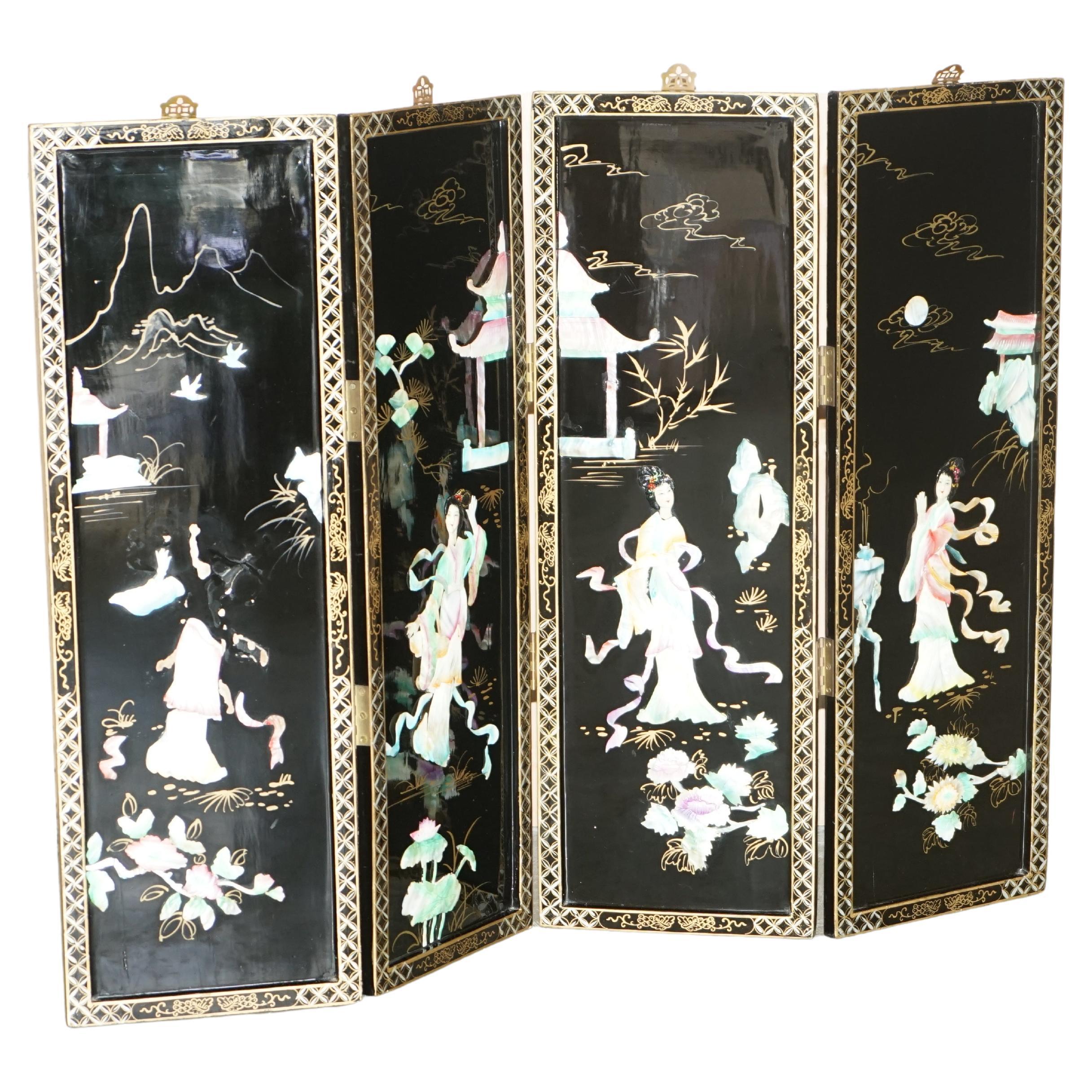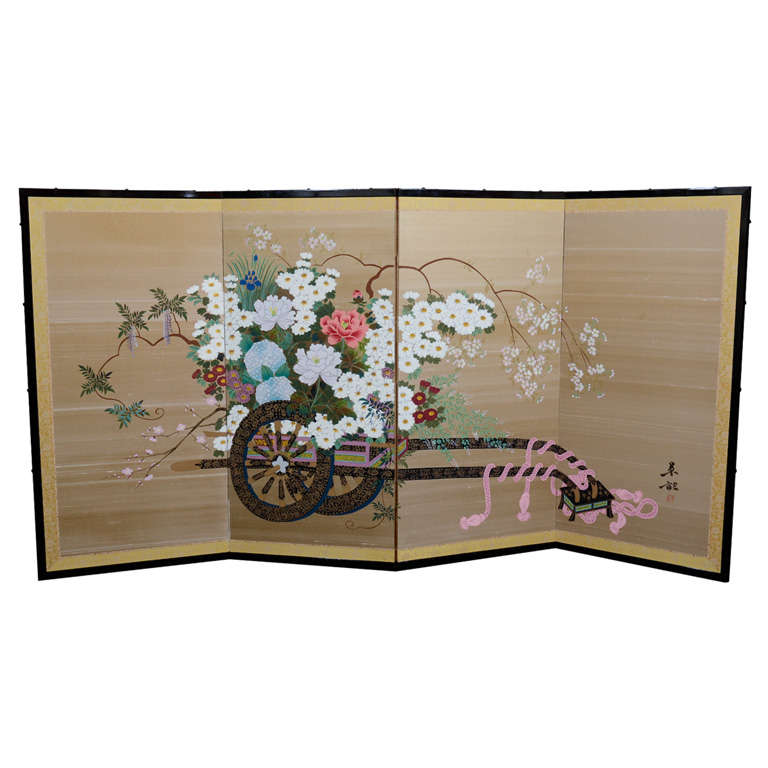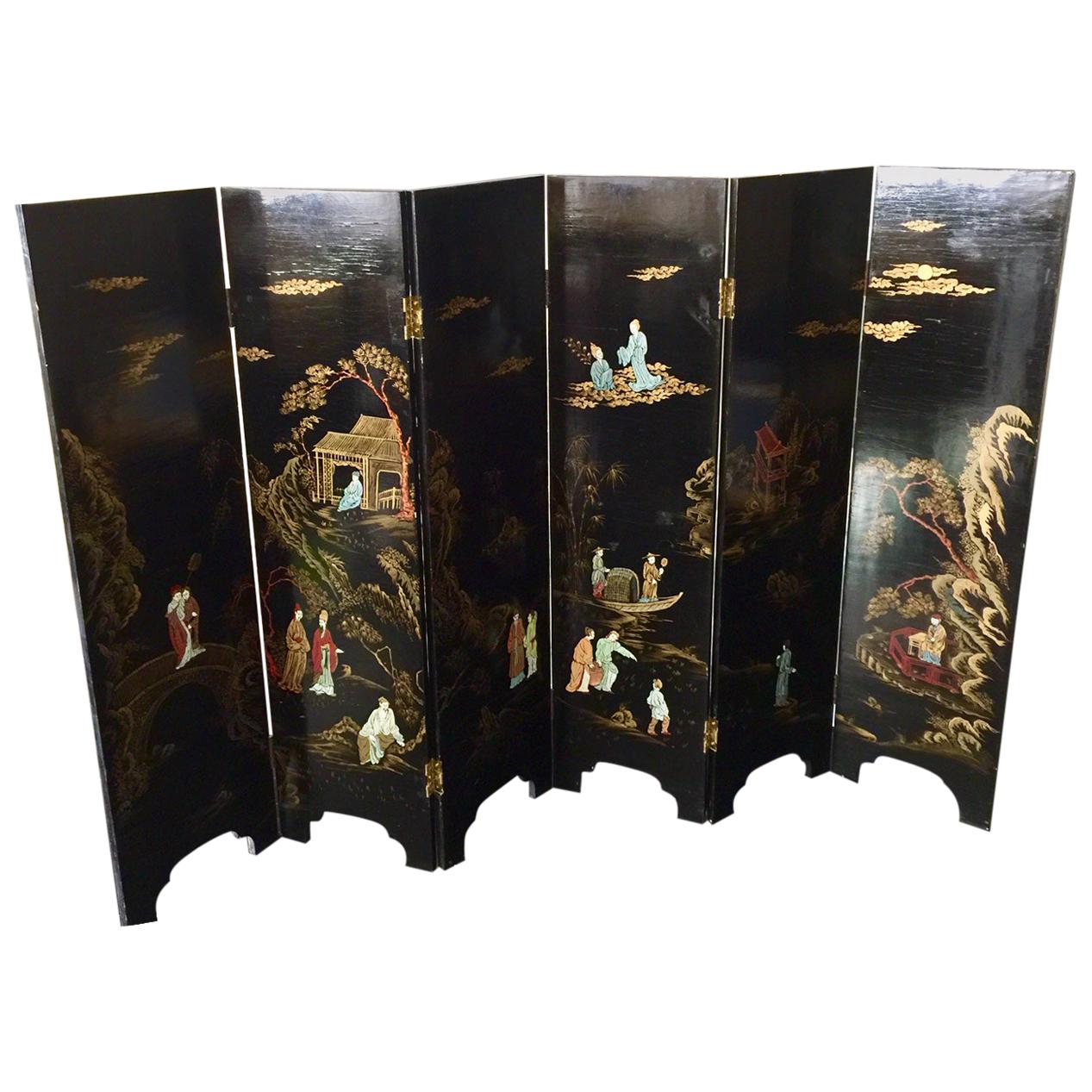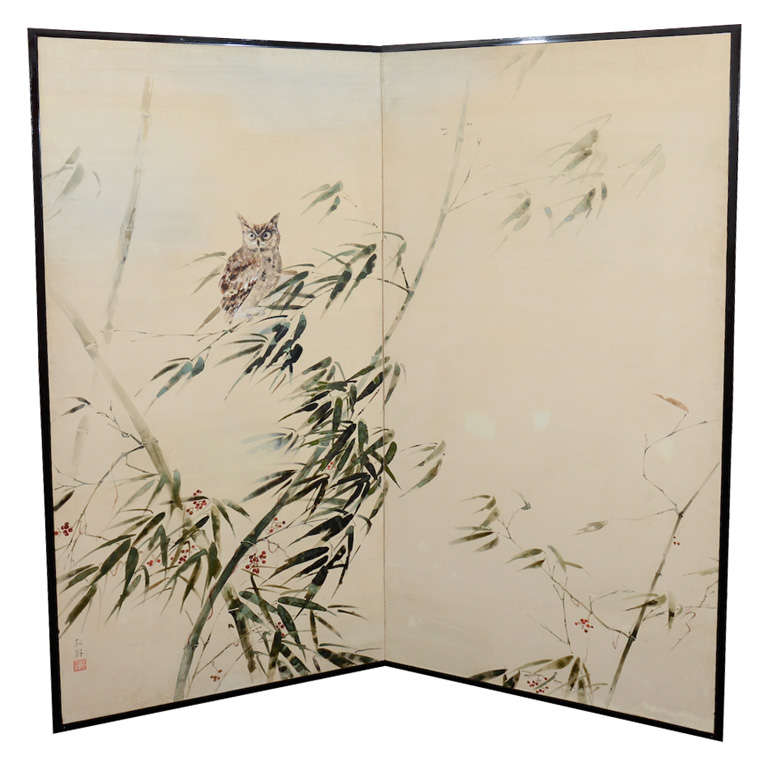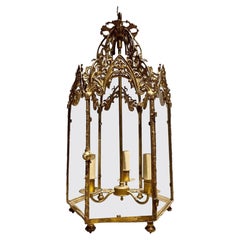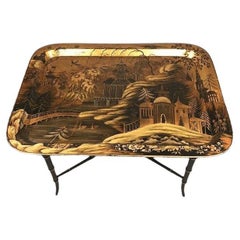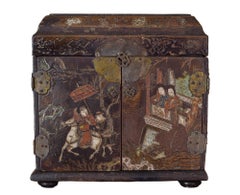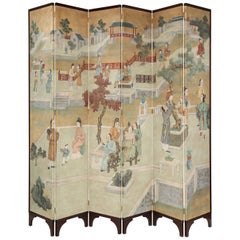
Antique Polychrome Painted and Gilt Decorated Six-Fold Leather Screen
View Similar Items
Want more images or videos?
Request additional images or videos from the seller
1 of 8
Antique Polychrome Painted and Gilt Decorated Six-Fold Leather Screen
About the Item
- Dimensions:Height: 87.8 in (223 cm)Width: 125.2 in (318 cm)Length: 87.8 in (223 cm)
- Materials and Techniques:
- Period:
- Date of Manufacture:circa 1800
- Condition:Wear consistent with age and use. In excellent condition.
- Seller Location:Lymington, GB
- Reference Number:Seller: BHA 10851stDibs: LU4081124302392
About the Seller
5.0
Vetted Seller
These experienced sellers undergo a comprehensive evaluation by our team of in-house experts.
Established in 1957
1stDibs seller since 2018
33 sales on 1stDibs
Typical response time: 8 hours
More From This SellerView All
- Antique Gothic Gilt Bronze Hall LanternLocated in Lymington, GBAn English 19th-century Gothic gilt-bronze hall lantern. George IV period, circa 1820-1830. In superb condition. Later adapted with a 3-way center and wiring. A very smart Georgian addition to a hallway, entry or foyer. Measures: H 2’3” (69 cm) W 12 ½” (31 cm) D 12 ½” (31 cm). Nb: A very similar antique Gothic lantern...Category
Antique 19th Century English Gothic Lanterns
MaterialsBronze
$12,670 / item - Regency Polychrome Papier Mache Chinoiserie Tray TableLocated in Lymington, GBA Regency period polychrome papier-mâché chinoiserie tray on a bespoke ebonised stand. Ca 1810. In excellent and original condition showing an exotic r...Category
Antique 1810s Regency Side Tables
MaterialsEbony
- Rare Chinese Kangxi Polychrome Coromandel Lacquer CasketLocated in Lymington, GBA rare Chinese polychrome Coromandel or ‘Bantam Ware’ lacquer casket or table cabinet, Kangxi period (1661-1722). Circa 1700. This fine small Chinese export lacquer fitted casket is decorated overall with polychrome incised decoration. Opening with two doors revealing a red interior with fitted drawers and a hinged rising top. In superb, almost entirely original condition, retaining its vivid colours and fine details with courtiers in a pavilion and on horseback amidst foliage and formal palace gardens. The small bun-type feet are historical replacements. Interestingly bearing an antique-script inventory #25 and A I on the base. Nb. Bantamwork or Coromandel lacquer, not to be confused with ‘japanning’, is the term applied to decoration that is cut into a layer of gesso and then lacquered in colours. Much of the lacquer was transhipped from China through Coromandel in India, or the Dutch colony Batavia, Java. References: Coromandel lacquer or ‘Bantamwork’, with its characteristic incised decoration, was made in Henan province in northern China from the latter part of the Ming dynasty and exported to Europe from the end of the 17th century through the East India Company’s and VOC trading posts on the Coromandel coast of India. The technique consisted in overlaying a base of wood with a series of increasingly fine white clays and fibrous grasses. Over this surface, lacquer was applied and polished before the design was incised and the hollowed out portions filled with colour and gilt and finished with a clear lacquer to protect it. Although John Stalker and George Parker used the term ‘Bantamwork’, the contemporary layman usually called it ‘cutt-work’, ‘cutt Japan’ or ‘hollow burnt Japan’. Stalker and Parker discuss two types of ‘Bantam-work’ – flat and incised – in their Treatise on Japanning and Varnishing of 1688, noting that it ‘was done in colorus mix’t with a gum water’. They also considered that it was ‘almost obsolete, and out of fashion, out of use and neglected….’ although admitted that ‘it was very pretty, and some are more fond of it, and prefer it to the other…’. This casket/ table cabinet now on offer is related to one formerly with Malletts and illustrated in A. Bowett, 'English Furniture 1660-1714: From Charles II to Queen Anne', Woodbridge, 2002, p. 150, plates 5:9. A much larger closely-related Bantam work coffer with rising lid was offered in the ‘Asian Art in Cologne’ sale lot 114 on 11th December 2021. Estimated @ £60,000 – £79,000. Mme de Pompadour, mistress to King Louis XV from 1745 to 1751, was an avid collector and admirer of Chinese Coromandel or Bantam work and was probably largely responsible for the very high prices recorded for such pieces, sometimes 10 times or more the price of ordinary furniture of equivalent quality. A Coromandel cabinet...Category
Antique 18th Century Chinese Cabinets
MaterialsLacquer
- Fine and Rare 17th Century Japanese Mulberry Wood Gilt-Lacquer Cabinet on StandLocated in Lymington, GBAn outstanding and rare, 17th-century Japanese mulberrywood gilt-lacquer cabinet raised on a later stand. This fine and exceptional two-door, gilt-heightened cabinet - reputedly in mountain mulberry wood...Category
Antique 17th Century Japanese Cabinets
MaterialsLacquer
- William & Mary Japanned Painted Dressing Table MirrorLocated in Lymington, GBAn extremely rare dressing table mirror of the William and Mary period, ca 1690. English, late 17th century, japanned and painted dressing table...Category
Antique 17th Century English William and Mary Table Mirrors
MaterialsWood
- Very Rare Carved Gilt Gesso Dressing Mirror, circa 1710-1720Located in Lymington, GBA very rare carved gilt gesso dressing mirror. Queen Anne / George I period, c 1710-20. Decorated all over with the original finely carved gilt-gesso surfaces with typical circular punched reserves. The hinged fall reveals a shaped, fitted interior, gilded and japanned (lacquered) in red. Some external carved surfaces show very minor areas of wear revealing the authentic bole and gesso ground. Overall in superb condition. Measures: H: 39 1/2’’ (100 cm) D: 12 1/2’’ (31.5 cm) W: 17 3/4’’ (45.5 cm). Reminiscent of the work of London-based James Moore (c 1670-1726), a supreme exponent of the art of cut gesso and gilding. This dressing table mirror is possibly unique in this form, and as such has survived over 300 years in remarkably original state. It may have been part of a suite of furniture, would have been extremely costly, and very much the reserve of the aristocracy and the wealthy in the early part of the 18th century. For documented pieces by James Moore viz. The Royal Collection Trust Wikipedia - James Moore (furniture designer) James Moore (circa 1670 - October 1726) was established at Short's Gardens, St. Giles-in-the-Fields. He was in partnership with John Gumley from 1714 and, unlike his partner, did not advertise - the sole published reference to him being a notice of his death in The Weekly Journal or The British Gazetteer. As Royal cabinet-maker he supplied walnut and mahogany furniture for the Royal Household, The Royal Yacht, and the King's servants and mistresses, as well as the rich gilt-gesso work for which he is best known. Moore is especially renowned for gilt-gesso furniture: tables; looking glass frames; and candle stands. A pair of gilt-gesso side tables bearing the crowned cypher of George I in The Royal Collection, and the pair of candle stands en-suite are incised with his name - an unusual practice at the time. At Erddig, such furniture by Moore can be linked to surviving bills and receipts from James Moore and John Belchier, 1722-26. Gilt-gesso furniture is also encountered in fine Louis XlV and other European furniture of the period. Literature: Ralph Edwards CBE FSA ’The Shorter Dictionary of English Furniture’ Hamlyn, London (Fourth Impression 1972) ill. 5, p. 363. One of a pair of looking glasses by James Moore, 1720. Erddig, Denbigh. The crest is reminiscent of that upon our dressing mirror, which we are offering here. Kreisel, Heinrich, 'Die Kunst Des Deutschen Mobels’ CH Beck, Munchen (1970) ill. 345, p. 347 - note similarities in the treatment of the top of the crest. This mirror was last seen in the collection of Augsburg Castle. Synge, Lanto, 'Great English Furniture' London (1991) p. 52. Refs: Symonds, R. W. 'A Royal Scrutoire', Connoisseur (June 1940) pp. 233-236. Symonds, R. W. ‘English Gesso Furniture’, The Antique Collector, Vol. XXVII (August 1956) p. 140. ‘A Golden Cabinet...Category
Antique Early 18th Century Queen Anne Table Mirrors
MaterialsGiltwood
You May Also Like
- Chinese Export Six Panel Gilt Lacquered Folding ScreenLocated in Rio Vista, CAGorgeous Chinese export six-panel lacquered folding screen featuring idyllic gilt landscape scenes. Each panel is decorated with a painted scene...Category
20th Century Chinese Chinese Export Screens and Room Dividers
MaterialsBrass
- Impressively Scaled Chinoiserie Hand Painted Silk Six-Fold ScreenLocated in New York, NYFinely painted Chinoiserie with Mandarin court figures engaged in leisurely and scholarly pursuits outdoors. Featuring a soft palette of parchment, blues, and green. With a solid dar...Category
20th Century European Paintings and Screens
MaterialsWood, Silk
- Japanese Showa Period Folding Screen with Painted CranesLocated in New York, NYJapanese Showa period four panel folding screen finely painted with a theme of cranes in four elegant positions. The piece is signed and was made in circa 1950 in Japan. In great vi...Category
Vintage 1950s Japanese Showa Paintings and Screens
MaterialsFabric, Wood, Paint
- Japanese Asian Large Edo Six-Panel Folding Byobu Screen Landscape Monkeys TreesLocated in Studio City, CAAn absolutely gorgeous, wonderfully composed six-panel Japanese byobu folding screen / room divider depicting a family of playful monkeys among the blooming trees and mountainous lan...Category
Antique Early 19th Century Japanese Edo Paintings and Screens
MaterialsGold Leaf
- Antique Japanese Six-Panel Screen by Kano ChikanobuLocated in Prahran, VictoriaLate 17th century Kano school peony landscape screens. One of a pair of screens signed: Hogan Josen Fujiwara Chikanobu Hitsu - Kano Chikanobu (Shushin) ...Category
Antique Early 18th Century Japanese Edo Paintings and Screens
MaterialsGold Leaf
- Japanese Asian Large Six-Panel Folding Byobu Flower Cart Screen, 19th CenturyLocated in Studio City, CAA gorgeous six-panel Japanese Byobu folding screen. Listing as Meiji period but could very possibly Edo period. Decorated with peonies, irises and...Category
Antique 19th Century Japanese Meiji Paintings and Screens
MaterialsGold Leaf
Recently Viewed
View AllMore Ways To Browse
Gilt Folding Panel
Painted Leather Room Screen
Eight Panel Screen
Gilt Folding Screen
Antique Leather Painted Screen
Leather Folding Screen
Chinoiserie Dress
Antique Dress 1800
Antique Painted Folding Screens
Divider Screen 4 Panel
2 Panel Folding Screen
3 Panel Screen Divider
4 Panel Room Divider Screen
Chinoiserie Folding Screen
Large 4 Panel Screen
Wallpaper Border
3 Panel Screen Room Divider
4 Panel Wall Screen
